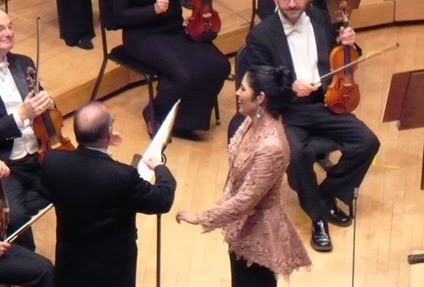“Farinelli could only have been proud — unless, of course, he was understandably jealous.”
 “The audience on Tuesday evening rewarded her performance with a standing ovation, an honor that in Symphony Hall still must be earned. Opening with ‘Alma oppressa da sorte crudele’ from Antonio Vivaldi’s La fida ninfa, composed for the celebrated Bolognese soprano Giovanna Gasparini, the bravura technique for which the singer is renowned was on dizzying form. The volleys of coloratura with which Licori contemplates the soul-crushing weight of misfortune were launched with brilliance, the darkness of the timbre increasing the emotional intensity of the nimbly-ornamented vocal line. ‘Dolci, freschi aurette’ from Nicola Porpora’s Polifemo—the first of the three arias in the programme that were composed for Farinelli—made equally formidable demands on Ms. Genaux’s technique but inspired her to even greater emotional connection: the beautiful melodic lines, a credit to their composer, were radiantly sung, and more than almost any other singer who specializes in this repertory Ms. Genaux consistently integrates vocal pyrotechnics into the interpretive nuances of her performances, embellishing da capo repeats lavishly but tastefully. Even when the sheer profusion of notes necessitates punctuating phrases with breaths, Ms. Genaux artfully conceals effort in displays of passionate but completely natural musical drama. The original design of the CSO concert had all four arias performed in succession, but as was explained in brief introductory remarks the decision was made to present two arias before the interval and two after, allowing—as Maestro McGegan quipped—Ms. Genaux to partake of ‘a glass of water before climbing Mount Everest.’ In vocal terms, the second pair of arias confirmed the suitability of the analogy. Composed by Porpora as a showpiece finale for the pastiche that was hashed out of Johann Adolf Hasse’s Artaserse, ‘Or la nube procellosa’ is the sort of aria at which Farinelli apparently excelled, the bristling bravura passages requiring both consummate technical skills and, ideally, an insightful use of text. Ms. Genaux disappointed in neither aspect, her mastery of the music allied with a native speaker’s usage of Italian. Farinelli’s brother, Riccardo Broschi, certainly was not a great composer, but he was eminently capable of creating music that exploited his brother’s vocal capabilities. ‘Qual guerriero in campo armato’ from Broschi’s Idaspe became Farinelli’s most iconic aria di baule: in whichever opera an audience heard the legendary castrato, they were likely to hear ‘Qual guerriero in campo armato.’ To the modern listener acquainted with the arias of Mozart, Verdi, Puccini, and even Rossini, the difficulties of ‘Qual guerriero in campo armato’ likely seem utterly ridiculous, and the slightest glance at the score leaves little doubt of why this music—and the bulk of Baroque vocal repertory in general—was neglected for more than two centuries. In the best of times, singers with the technique needed to survive ‘Qual guerriero in campo armato’—merely to survive the aria, not to sing it well—are very rare: without question, it was beyond the capacities of most of Farinelli’s castrato contemporaries. Listeners who are acquainted with Pyrotechnics, her recital disc of Vivaldi arias, perhaps were not surprised by the way in which Ms. Genaux dominated Broschi’s relentlessly lung-busting music, but it is unfathomable that anyone in Symphony Hall on Tuesday evening was not dazzled by her performance. Not only was her singing of the rapid-fire coloraturaspot-on, both in pitch and in rhythm, but the leaps from top to bottom of the range were perfectly managed. The sharply-differentiated lilting passages were highlighted by Ms. Genaux’s firm, intense delivery of text, supported with ideal synchronicity by Maestro McGegan and the CSO. A special joy of Ms. Genaux’s singing were her trills: for once, these were actual alternations between two distinct pitches, delivered in the correct rhythms. Were he on hand to hear such a performance of music that his gifts inspired, Farinelli could only have been proud—unless, of course, he was understandably jealous.”
“The audience on Tuesday evening rewarded her performance with a standing ovation, an honor that in Symphony Hall still must be earned. Opening with ‘Alma oppressa da sorte crudele’ from Antonio Vivaldi’s La fida ninfa, composed for the celebrated Bolognese soprano Giovanna Gasparini, the bravura technique for which the singer is renowned was on dizzying form. The volleys of coloratura with which Licori contemplates the soul-crushing weight of misfortune were launched with brilliance, the darkness of the timbre increasing the emotional intensity of the nimbly-ornamented vocal line. ‘Dolci, freschi aurette’ from Nicola Porpora’s Polifemo—the first of the three arias in the programme that were composed for Farinelli—made equally formidable demands on Ms. Genaux’s technique but inspired her to even greater emotional connection: the beautiful melodic lines, a credit to their composer, were radiantly sung, and more than almost any other singer who specializes in this repertory Ms. Genaux consistently integrates vocal pyrotechnics into the interpretive nuances of her performances, embellishing da capo repeats lavishly but tastefully. Even when the sheer profusion of notes necessitates punctuating phrases with breaths, Ms. Genaux artfully conceals effort in displays of passionate but completely natural musical drama. The original design of the CSO concert had all four arias performed in succession, but as was explained in brief introductory remarks the decision was made to present two arias before the interval and two after, allowing—as Maestro McGegan quipped—Ms. Genaux to partake of ‘a glass of water before climbing Mount Everest.’ In vocal terms, the second pair of arias confirmed the suitability of the analogy. Composed by Porpora as a showpiece finale for the pastiche that was hashed out of Johann Adolf Hasse’s Artaserse, ‘Or la nube procellosa’ is the sort of aria at which Farinelli apparently excelled, the bristling bravura passages requiring both consummate technical skills and, ideally, an insightful use of text. Ms. Genaux disappointed in neither aspect, her mastery of the music allied with a native speaker’s usage of Italian. Farinelli’s brother, Riccardo Broschi, certainly was not a great composer, but he was eminently capable of creating music that exploited his brother’s vocal capabilities. ‘Qual guerriero in campo armato’ from Broschi’s Idaspe became Farinelli’s most iconic aria di baule: in whichever opera an audience heard the legendary castrato, they were likely to hear ‘Qual guerriero in campo armato.’ To the modern listener acquainted with the arias of Mozart, Verdi, Puccini, and even Rossini, the difficulties of ‘Qual guerriero in campo armato’ likely seem utterly ridiculous, and the slightest glance at the score leaves little doubt of why this music—and the bulk of Baroque vocal repertory in general—was neglected for more than two centuries. In the best of times, singers with the technique needed to survive ‘Qual guerriero in campo armato’—merely to survive the aria, not to sing it well—are very rare: without question, it was beyond the capacities of most of Farinelli’s castrato contemporaries. Listeners who are acquainted with Pyrotechnics, her recital disc of Vivaldi arias, perhaps were not surprised by the way in which Ms. Genaux dominated Broschi’s relentlessly lung-busting music, but it is unfathomable that anyone in Symphony Hall on Tuesday evening was not dazzled by her performance. Not only was her singing of the rapid-fire coloraturaspot-on, both in pitch and in rhythm, but the leaps from top to bottom of the range were perfectly managed. The sharply-differentiated lilting passages were highlighted by Ms. Genaux’s firm, intense delivery of text, supported with ideal synchronicity by Maestro McGegan and the CSO. A special joy of Ms. Genaux’s singing were her trills: for once, these were actual alternations between two distinct pitches, delivered in the correct rhythms. Were he on hand to hear such a performance of music that his gifts inspired, Farinelli could only have been proud—unless, of course, he was understandably jealous.”
- www.voix-des-arts.com READ THE COMPLETE REVIEW
“The Alaska-born mezzo is among a handful of contemporary singers who can tackle this forgotten, hugely demanding repertory without flinching, while breathing new life and expressive urgency into it. In arias by Antonio Vivaldi, Nicola Porpora and Farinelli’s elder brother Riccardo Broschi, she exhibited many of the virtues that so enthralled the public of Farinelli’s day.
The dark beauty and focus of her sound, combined with her uncanny facility and accuracy she brought to the most ornate coloratura passages, were impressive indeed. Genaux is one Baroque singer who never sacrifices dramatic truth to “authenticity.”
- John von Rhein / Chicago Tribune
BRAVISSIMA, VIVICA!

